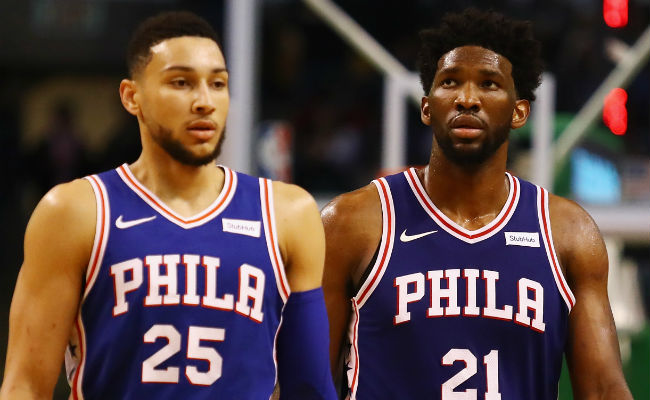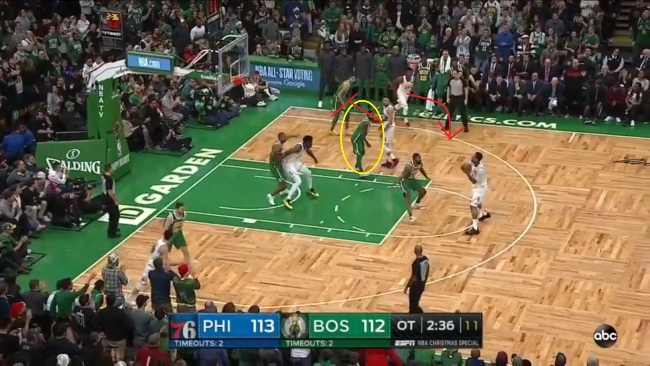
The Jimmy Butler trade has been a smashing success for the Philadelphia 76ers. After scuffling a bit out of the gates, the Sixers have a 113.7 offensive rating following the acquisition of Butler — up 5.6 points per 100 possessions from their pre-trade mark. The star trio of Butler, Ben Simmons and Joel Embiid (a sneaky MVP candidate averaging 26 points, 13 rebounds and 3.5 assists per game while leading the NBA in free throw attempts) has posted a 112 oRTG in 648 possessions together.
There have been some galvanizing moments, from multiple Butler game winners to a furious comeback against the Nets in Brooklyn, but Philadelphia’s loss on Christmas Day to a member of the Eastern Conference’s elite served as a reminder of some of the structural issues the Sixers face with their current roster.
The team has played 11 games with “clutch” minutes (defined by NBA.com as being within five points with five minutes or fewer to go in the fourth quarter and all overtime minutes) since the Butler trade. The Sixers — despite being 7-4 in these contests — have posted a 103.2 oRTG in those minutes. This includes a dismal 13 points on 21 clutch possessions (shooting just 17.6 percent from the field) on Christmas Day.
As the season progresses, Brett Brown and his staff must explore how successful the offense can be when Ben Simmons plays off the ball in crunch time. The famously jumper-averse Simmons is just 4-for-24 outside of the paint this season, a complicating factor when playing next to a dominant center in Embiid.
Here’s an example against a different elite squad in the East, the Toronto Raptors. Watch as Butler and Embiid try to run a simple side ball screen action with Simmons in the dunker spot. Though Butler initially seems to turn the corner on Kawhi Leonard, he is greeted by Pascal Siakam — who is guarding Simmons — as he nears the basket.
The same issue occurred on Christmas Day when Butler and Embiid went back to the right wing ball screen.
The problem isn’t necessarily Simmons himself — though his usual desire to shoot layups right-handed does shorten recovery distance — but rather, his positioning.
Stationing a player in the weakside corner on these actions frees up the hammer pass for the ball-handler and increases the recovery time for a scrambling defense. It also forces the corner player’s defender to make a choice between tagging the roll man and defending a possible corner three.

As you can see, the Raptors and Celtics are faced with no such issue because Simmons is hanging out so close to the rim. The equation doesn’t change when the initial ball screen is shifted to the center of the floor. Watch Jarrett Allen execute drop coverage on this action.
Despite Butler having an advantage on Joe Harris off the bounce (and Brooklyn staying in-touch with shooters in both corners), Allen is able to recover to Embiid early. This is because Allen knows he has help in the form of Simmons’ defender hanging out at the rim.

Unsurprisingly, stationing Simmons on the wing does little to assuage the spacing conundrum. He might as well be hanging out in the dunker spot with how Anthony Davis tags Embiid to a touch on this roll.
Perhaps the fix is as simple as running a pick-and-pop as the initial action rather than having Embiid roll into traffic…
… but Embiid is shooting a paltry 28 percent from behind the arc this season. When you compare that to his 1.04 points per Post Up possession (and the fact that he has gotten to the free throw line on 27 percent of his 303 Post Ups), it’s hard to honestly state this is a positive play outcome.
Philadelphia has found great success with this simple action, which combines an initial pick and pop with an Embiid post up.
Someone, often Wilson Chandler, will set a dummy screen for Simmons and pop to the top of the key. At the same time, Embiid will seal his defender in the lane while the Sixers station a shooter in either corner. However, against the Celtics, after Embiid hammered Daniel Theis on the action early, Boston was prepared for its revival in overtime.
Watch as Irving and Morris switch the initial ball screen, recognizing it to be a dummy action. This leaves Irving in position to help off Simmons and cut off the pass to Embiid, who had established seal position in the lane.
This action remains preferable to a straight Embiid ISO post touch, where the Sixers have struggled to find the right floor balance at times.
After Butler enters the ball to Embiid from the wing, he makes the natural baseline cut and continues through to the other wing. The only problem? Simmons is already stationed in the dunker spot and Chandler in the opposite corner, allowing Boston to double Embiid.
Perhaps adjustments will come with time; it’s important to remember that while the Sixers have been good with Butler, they’re still learning how to incorporate a third star on the fly. Butler could dummy a cut through and zip to the near-side corner for three. Simmons could flash high post, leaving Hayward with the task of marking Butler’s cut and Chandler in the weakside corner. Butler could pass and screen away for Redick, perhaps discouraging the double team from ever coming.
However, all of the choices underscore the difficulty of operating the offense through Butler in the closing minutes. The other obvious answer is to move Simmons back on-ball, a situation where Philly typically likes to involve J.J. Redick as either a screener or in dribble hand-off actions.
Watch this Horns DHO action where Redick receives the hand-off coming to his preferred right hand. Note that Embiid fakes a double screen for Redick and seals Allen, giving the Sixers optionality on the action.
Another possibility is to use Simmons as a screener for Butler, an unconventional archetype that takes advantage of one of Simmons’ greatest strengths at LSU.
With Embiid spacing to the top of the key, you will notice that nobody replaces Simmons in the dunker spot, opening the floor for his roll. But in the above two plays, that’s all Butler and Embiid, respectively, are reduced to: spacers. Both are effective actions, but they abandon any notion of involving the trio all at once.
Is that sustainable? That’s hard to say. A noted closer, Butler has presented problems in the past when his number wasn’t getting called. Embiid, meanwhile, has publicly voiced his frustration with his role, saying “the ball didn’t find me” down the stretch against the Celtics.
Brown has successfully played Simmons and Butler together with Embiid on the bench, using Mike Muscala as a spacing five and accounting for most of Butler’s successful passes out of ball screen actions. But the Butler-Embiid duo has largely remained attached to Simmons, as they have only played 98 possessions together with the second-year forward resting.
While I would love to live in an alternate reality where Simmons attempts two threes per game for a five-game stretch just to see what happens, that doesn’t appear to be on the horizon any time soon. Instead, Brown has to continue to experiment with counters to defenders helping off Simmons. Lifting him out of the dunker spot and into a role as an off-ball screener is a good start.
On the Butler-Embiid high ball screen action where Davis completely ignored Simmons, he could easily go set a pindown for Redick in the weakside corner. This would function in a Spain PnR-like fashion where a ball screen leads to one man rolling and one popping to the top of the arc.

On the deep seal play where Irving cut off the entry to Embiid, Simmons could sprint to the corner after his pass to Chandler and set a pindown for Butler to curl.

Ultimately, this iteration of the Sixers is still an evolving organism. They have plenty of time to figure things out offensively before they face a true test in the Playoffs. These are wrinkles Brown has time to employ and tweak based on their effectiveness.
But the Christmas Day game demonstrated that the Sixers still have underlying issues when it comes to fitting their “Big 3” together, and they start with how Simmons can operate off the ball.






